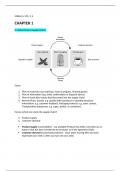Midterm: Ch1, 3, 4
CHAPTER 1
1.1 What Starts a Supply Chain?
Flows:
1. Flow of materials (raw materials, work in progress, finished goods)
2. Flow of information (e.g. order confirmation or dispatch advice)
3. Flow of funds (the money that flows back into the supply chain)
4. Reverse flows: (Goods, e.g. quality defect products or obsolete products,
Information, e.g. customer feedback, Packaging material, e.g. outer cartons,
Transportation equipment, e.g. cages, pallets, or containers)
Forces (which one starts the supply chain?)
5. Product supply
6. Customer demand
Product Supply (commodities) - any available Product that Seller currently has on
hand or that has been transferred to the Buyer as of the Agreement Date.
Customer demand (customised products) - chain starts moving after you have
expressed your wish or after you have set your order.
,1.2 A Functional View of Supply Chain Management
Generic functional processes in the supply chain (PSMDR) (score):
1. Plan process: balance demand and supply
2. Source process: selecting suppliers
3. Make process: set up manufacturing
4. Deliver process: order management, logistics
5. Return process: post delivery customer support
Purchasing or procurement - describes the process of buying goods or services to
meet planned or actual demand.
1.3 Supply Chain Architecture
, Supply chain players:
Suppliers
Own company
Customers
Service providers (transportation, warehousing, IT, etc.)
CHAPTER 3
3.1 Introduction to Sourcing
Main business activities:
Selecting new suppliers - this includes finding suppliers that provide products and/or
services that best meet the required needs, analysing them and setting up contracts.
Manage the supplier over a period of time - this could be short, such as a one-off
purchase such as a factory buying a new generator. Or it could be a much longer
time period, such as a component supplier providing daily core materials for an
electronics manufacturer over several years.





